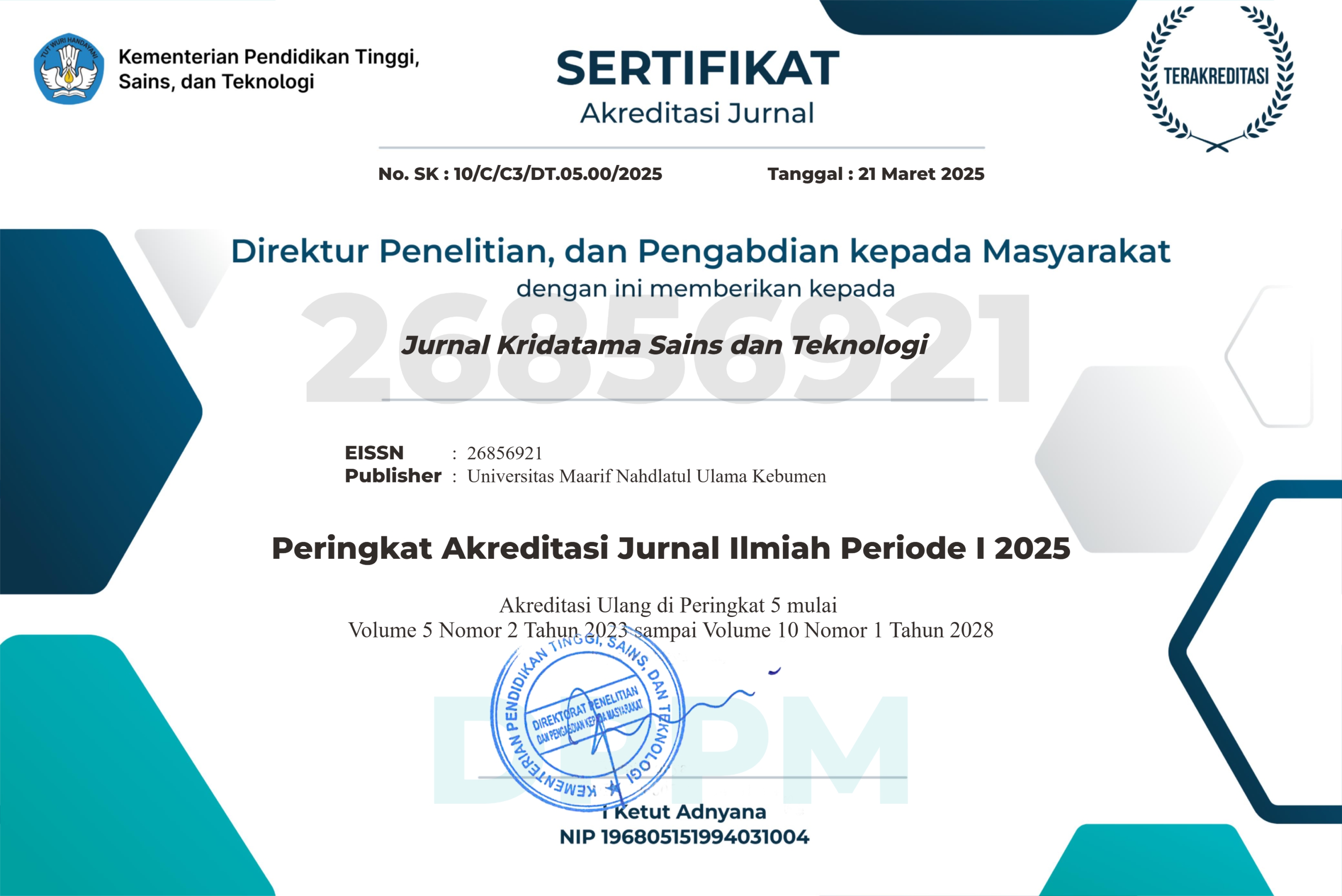Pengujian Black Box Testing Pada Sistem Website Osha Snack: Pendekatan Teknik Boundary Value Analysis
DOI:
https://doi.org/10.53863/kst.v6i02.1407Keywords:
Application Testing, Black Box, Sales System, Boundary Value AnalysisAbstract
This study functional quality testing of the Osha Snack website was conducted using the Black Box Testing method with the Boundary Value Analysis (BVA) technique approach. Osha Snack is an e-commerce platform that provides online-based snack products. Black Box Testing was chosen because of its ability to rotate the system without checking the internal code, focusing on the input and output provided by the user. BVA tests input limits, such as minimum, maximum, and out-of-bounds values, to identify potential problems in the most vulnerable areas. The test results show that the system successfully handles valid input according to functional specifications and provides effective validation for input that exceeds the desired limits, with a percentage reaching 96% of all tested scenarios. This technique has been shown to improve the accuracy and stability of the system with wide test coverage but is efficient in terms of time and resources. However, BVA has limitations, namely it does not cover internal logic testing and does not detect errors outside the tested boundaries. This study significantly contributes to developing a more reliable e-commerce platform through an optimal software testing process.
References
Arwin, D., Wulan, D., & Rizqon Adinata, H. (2023). Measuring Information System-Based Village Administration Service Performance Using Boundary Value Analysis Techniques. Journal Of Informatics And Telecommunication Engineering, 6(2), 445–457. Https://Doi.Org/10.31289/Jite.V6i2.8235
Debiyanti, D., Sutrisna, S., Budrio, B., Kamal, A. K., & Yulianti, Y. (2020). Pengujian Black Box Pada Perangkat Lunak Sistem Penilaian Mahasiswa Menggunakan Teknik Boundary Value Analysis. Jurnal Informatika Universitas Pamulang, 5(2), 162. Https://Doi.Org/10.32493/Informatika.V5i2.5446
Dobslaw, F., Feldt, R., & Neto, F. De O. (2022). Automated Black-Box Boundary Value Detection (No. Arxiv:2207.09065). Arxiv. Https://Doi.Org/10.48550/Arxiv.2207.09065
Fahrezi, A., Salam, F. N., Ibrahim, G. M., Rahman, R., & Saifudin, A. (2022). Pengujian Black Box Testing Pada Aplikasi Inventori Barang Berbasis Web Di Pt. Aino Indonesia. Logic : Jurnal Ilmu Komputer Dan Pendidikan, 1(1), 1–5. Https://Www.Journal.Mediapublikasi.Id/Index.Php/Logic/Article/View/1262
Giombi, K., Viator, C., Hoover, J., Tzeng, J., Sullivan, H. W., O’donoghue, A. C., Southwell, B. G., & Kahwati, L. C. (2022). The Impact Of Interactive Advertising On Consumer Engagement, Recall, And Understanding: A Scoping Systematic Review For Informing Regulatory Science. Plos One, 17(2), E0263339. Https://Doi.Org/10.1371/Journal.Pone.0263339
Hendartie, S., Jayanti, S., Sutejo, H., Palangkaraya, S., Palangkaraya, S., No, J. G. O., Raya, K. P., & No, J. A. R. (2023). Pengujian Aplikasi Penerimaan Mahasiswa Baru (Pmb) Stmik Palangkaraya Menggunakan Black Box Testing. Jurnal Sains Komputer Dan Teknologi Informasi, 5(2), 31–40. Https://Doi.Org/10.33084/Jsakti.V5i2.5021
Jailani, A., & Yaqin, M. A. (2024). Pengujian Aplikasi Sistem Informasi Akademik Menggunakan Metode Blackbox Dengan Teknik Boundary Value Analysis. Jacis : Journal Automation Computer Information System, 4(2), 60–66. Https://Doi.Org/10.47134/Jacis.V4i2.7
Ma’ruf, L. A. A., Kartiko, C., & Wiguna, C. (2020). Black Box Testing Boundary Value Analysis Pada Aplikasi Submission System. Edik Informatika, 6(2), 15–22. Https://Doi.Org/10.22202/Ei.2020.V6i2.3995
Maulana, B. A., Mawarni, E., Hidayattuloh, M. Y., Suryawijaya, V., & Saifudin, A. (2023). Pengujian Black Box Pada Sistem Informasi Barang Berbasis Web Menggunakan Metode Boundary Value Analysis. Oktal : Jurnal Ilmu Komputer Dan Science, 2(6), 1747–1753. Https://Journal.Mediapublikasi.Id/Index.Php/Oktal/Article/View/3094
Melati. (2024). Peran E-Commerce Dalam Mengembangkan Bisnis Di Era Digital. Jurnal Dialoka: Jurnal Ilmiah Mahasiswa Dakwah Dan Komunikasi Islam, 3(1), 69–84. Https://Doi.Org/10.32923/Dla.V3i1.4589
Nurudin, M., Jayanti, W., Saputro, R. D., Saputra, M. P., & Yulianti, Y. (2019). Pengujian Black Box Pada Aplikasi Penjualan Berbasis Web Menggunakan Teknik Boundary Value Analysis. Jurnal Informatika Universitas Pamulang, 4(4), 143. Https://Doi.Org/10.32493/Informatika.V4i4.3841
Perbawa, D. S., & Nurohim, G. S. (2020). Pengujian Aplikasi Berbasis Website Dengan Black Box Testing Metode Boundary Value Analysis Dan Responsive Testing. Journal Speed–Sentra Penelitian Engineering Dan Edukasi, 12(4). Http://Dx.Doi.Org/10.55181/Speed.V12i4.669
Putri, A. A., Husna, A. D., Nabilah, P., & Wikansari, R. (2024). Menghadapi Tantangan Pasar Baru Dalam Bisnis E-Commerce Di Indonesia. Jurnal Ilmiah Manajemen Ekonomi Dan Akuntansi, 1(2), 126–137. Https://Doi.Org/10.62017/Jimea
Putri, S., Azizah, A., Hermawan, I., & W, D. V. (2024). Pengembangan Platform Digital Melalui E-Katalog Dalam Rangka Diseminasi Informasi Pada Pt. Uola Pandawa Sejahtera Di Yogyakarta. Jurnal Kridatama Sains Dan Teknologi, 6(01), 335–349. Https://Doi.Org/10.53863/Kst.V6i01.1147
Sari, N. D., Ratmananda, D., Zulfikar, M. R., Putri, R. S., & Natasia, S. R. (2023). Analisa Usability Pada Website Disdukcapil Kabupaten Ketapang. Jurnal Kridatama Sains Dan Teknologi, 5(02), 373–384. Https://Doi.Org/10.53863/Kst.V5i02.950
Yulistina, S. R., Nurmala, T., Supriawan, R. M. A. T., Juni, S. H. I., & Saifudin, A. (2020). Penerapan Teknik Boundary Value Analysis Untuk Pengujian Aplikasi Penjualan Menggunakan Metode Black Box Testing. Jurnal Informatika Universitas Pamulang, 5(2), 129. Https://Doi.Org/10.32493/Informatika.V5i2.5366
Downloads
Published
How to Cite
Issue
Section
License
Copyright (c) 2024 Fatih Kawakib Kartono, Syifa Nursaadah, Mario Raditya Nugroho, Dimas Akbar Tama, Ferrol Azki Mashudi, Aditya Wicaksono, Muhammad Nasir

This work is licensed under a Creative Commons Attribution-ShareAlike 4.0 International License.
Authors retain copyright and grant the journal right of first publication with the work simultaneously licensed under a Creative Commons Attribution-ShareAlike 4.0 International License that allows others to share the work with an acknowledgment of the work’s authorship and initial publication in this journal

















